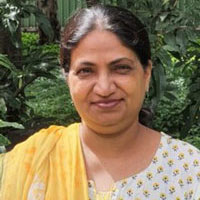Rucha Trivedi, Archana Gaikwad
Tekton
Tekton: Volume 10, Issue 1, July 2023
pp. 32 – 46
 Rucha Trivedi A budding architect by profession, has completed her bachelor’s from L. J. School of Architecture, Ahmedabad. Further on, she has worked with SAGA, Bhavnagar after graduation. She developed keen interest in sustainable designs which lead to pursuing master’s Course of Sustainable Architecture at Bharati Vidyapeeth (Deemed University)’s college of architecture, Pune. She has worked as an intern with Vivart, Ahmedabad, dealing in green building consultation.
Rucha Trivedi A budding architect by profession, has completed her bachelor’s from L. J. School of Architecture, Ahmedabad. Further on, she has worked with SAGA, Bhavnagar after graduation. She developed keen interest in sustainable designs which lead to pursuing master’s Course of Sustainable Architecture at Bharati Vidyapeeth (Deemed University)’s college of architecture, Pune. She has worked as an intern with Vivart, Ahmedabad, dealing in green building consultation.
21.rucha@bvcoa.in
 Archana Gaikwad An architect and environmental planner. She graduated from Shivaji university, Kolhapur and completed her PG studies from CEPT, Ahmedabad. She is working with M.Arch. (Sustainable Architecture) department at Bharati Vidyapeeth (Deemed University)’s College of Architecture, Pune as a professor. Presently, she is the chairperson BOS in Architecture, BVDU, Pune.
Archana Gaikwad An architect and environmental planner. She graduated from Shivaji university, Kolhapur and completed her PG studies from CEPT, Ahmedabad. She is working with M.Arch. (Sustainable Architecture) department at Bharati Vidyapeeth (Deemed University)’s College of Architecture, Pune as a professor. Presently, she is the chairperson BOS in Architecture, BVDU, Pune.
avg@bvcoa.in
ABSTRACT
Climate plays an important role in design of traditional houses. They are required to achieve human thermal comfort without the use of active systems. These houses have distinct forms and features that responds to local climate. In India, with wide cultural variations, the climatic response takes varied forms in different regions to suit local culture and traditions. Most of the studies while analyzing a traditional house for climate responsiveness lack scientific approach and generally are descriptive without any framework of analysis. With a wide variety of house forms, it is worth analyzing strategies which are used to respond to specific climate. The purpose of this paper is to document and analyze various strategies and house forms designed to achieve ventilation in warm and humid climates. First, based on the review of literature a framework is proposed to analyze climatic response of a traditional house form in warm and humid climate by identifying strategies and resulting features. Second, using this framework, a traditional house in the same climate is analyzed. The results are also triangulated using other methods such as climatic data records and user interviews.
KEY WORDS:
Traditional House Form, Climate Response, Kathiyawadi Haveli, Shading, Ventilation

